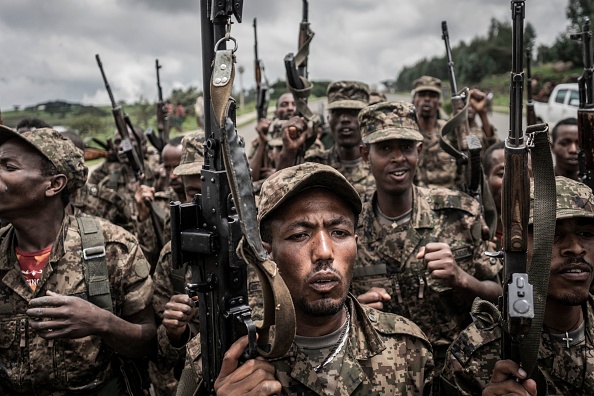Addis Ababa – The war in northern Ethiopia is moving south, with rebel groups claiming strategic wins over government forces and threatening to advance on Addis Ababa.
These are the main actors in a year-long conflict that has killed thousands and pushed many more into famine:
Ethiopian National Defence Forces
Ethiopia’s national military is one of the biggest standing armed forces in Africa, with an estimated 140,000 personnel.
Its air force has fighter jets and armed drones, which have stepped up raids over Tigray in recent weeks.
The ENDF has considerable battle experience, fighting wars with Eritrea, quelling rebellions and confronting Islamist militants in Somalia.
ALSO READ | Ethiopia capital could be overrun in ‘months if not weeks’, rebels say
Prime Minister Abiy Ahmed sent the ENDF into Tigray after accusing its former rulers, the Tigray People’s Liberation Front (TPLF), of orchestrating attacks on federal army camps.
The ENDF captured Tigray’s capital Mekele in a few weeks and Abiy declared victory.
But in June, the rebels retook Mekele and pushed into the neighbouring regions of Afar and Amhara.
The military has offered no figures of its own casualties.
Tigrayan rebels
The TPLF dominated the political alliance that ruled Ethiopia for nearly 30 years until anti-government protests swept Abiy to power in 2018.
At the outset of fighting the TPLF had a large paramilitary force and well-trained local militia possibly numbering 250,000 men in total, the International Crisis Group (ICG) says.
They were battle-hardened, having led the struggle that toppled Ethiopia’s autocratic regime in 1991 and fighting a brutal border war with Eritrea.
ALSO READ | Ethiopia’s Abiy vows victory, as army fights Tigrayan rebels for key town
Abiy’s government has accused the rebels of atrocities including massacres and conscripting and drugging child soldiers.
In June, the TPLF returned in triumph to Mekele, parading thousands of bedraggled federal soldiers through the streets.
In late October, in a fresh offensive, they claimed control of Dessie and Kombolcha, two cities just 400 kilometres (250 miles) north of Addis Ababa.
Its leaders say their goals are to deny Abiy’s forces the chance to return to Tigray, and to break what the UN calls a de facto aid blockade.
TPLF spokesman Getachew Reda has not ruled out marching on Addis Ababa “if that’s what it takes to break the siege on Tigray.”
Oromo fighters
The Oromo Liberation Army (OLA), an insurgent group bent on overthrowing Abiy, has linked up with the TPLF on the battlefield and claims control of territory in Amhara and Oromia, including near Addis Ababa.
This means it could potentially disrupt supply routes to the capital. A spokesman for the OLA said on November 3 that Addis Ababa could fall within “months if not weeks”.
Ethiopia declared the TPLF and OLA terrorist organisations in May, helping nudge the historic foes towards an unlikely military pact against their common enemy.
ALSO READ | Ethiopia forces, Tigrayan rebels battle over key town
The OLA broke off from the Oromo Liberation Front, an opposition party that spent years in exile but was allowed to return to Ethiopia after Abiy took office.
Believed to number in the low thousands, it is fighting for self-determination for the Oromo, Ethiopia’s largest ethnic group.
OLA combatants have longstanding grievances with ethnic Amharas, and Abiy’s government has accused the OLA of massacres.
Amhara forces
Regular and irregular combatants from Amhara have been a major ally of government forces since the war began.
These militias occupied areas of southern Tigray and seized the region’s fertile west, which ethnic Amharas consider part of their homeland.
Over the last year, ethnic Amharas have been returning to western Tigray and occupying abandoned homes and farmland in a state-backed campaign the United States has described as “ethnic cleansing”.
ALSO READ | Rebels claim control of Ethiopian city, sparking govt denials
Amharas claim western Tigray was stolen from them decades ago when the TPLF ruled the country.
Their involvement in the conflict has fanned ethnic hostilities.
As the TPLF has advanced further into the region, Amhara leaders have warned their very existence is at stake and urged locals to join the fight.
Eritrea
Tigray borders Eritrea, whose leader Isaias Afwerki is close to Abiy and a sworn enemy of the TPLF which ruled Ethiopia when both countries fought their border war.
For months, Addis Ababa and Asmara flatly denied the presence of Eritrean troops in Tigray, despite persistent eyewitness testimony to the contrary.
ALSO READ | Fighting rages on as Ethiopia’s war hits one-year mark
Abiy finally acknowledged their presence in March and said their departure was imminent.
But they remain in Tigray and it is unclear whether Abiy could make them leave – or afford to let them go.
All sides in the war have been accused of atrocities but the role of Eritrean forces in mass rape and murder has been well documented.
Follow African Insider on Facebook, Twitter and Instagram
Picture: Getty Images
Source: AFP
For more African news, visit Africaninsider.com


